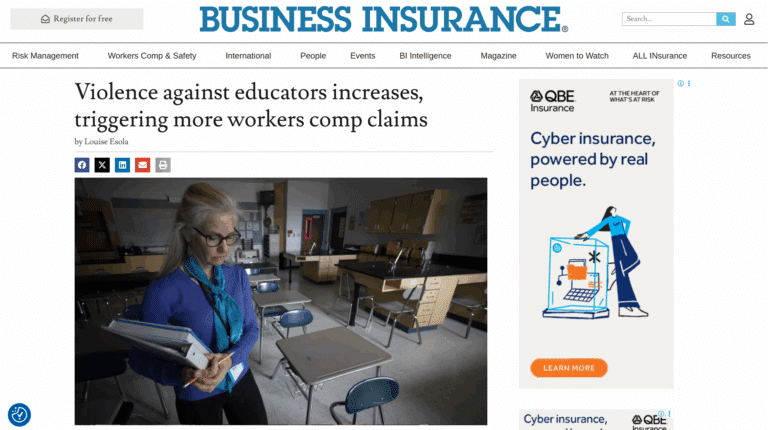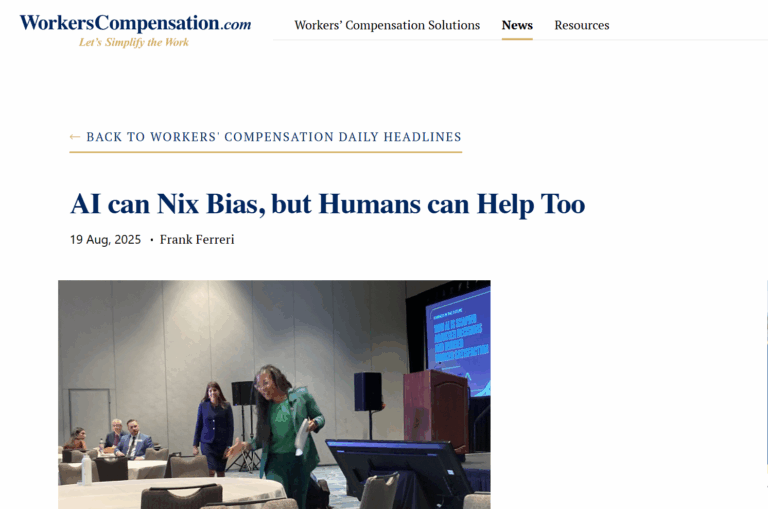In the wake of the Great Resignation comes a new movement dubbed “quiet quitting” leaving some carriers with a disengaged workforce.
In recent months, quiet quitting has become a popular workforce topic as employees respond to the stressors of the Great Resignation and the ongoing impact of the COVID-19 pandemic. The mentality around this concept is that employees are reprioritizing their time and will no longer be extending themselves above and beyond in their role, limiting their production to “act their wage” within the strict confines of their job description.
The phenomenon of quiet quitting is misleading because employees still perform their duties without quitting work entirely. However, as the employees pull back—while administering tasks outside their skillset or interests and enduring prolonged periods of pressure in an under-resourced team—they may become disengaged, sometimes to the point of no return.
If this sounds like it could be happening in your workforce, you can take steps to address this challenge, foster recruitment success and long-term talent retention, and address evolving employee needs.
Prioritize purpose and diversity in recruiting
Organizations must emphasize a recruitment approach that matches candidates with career opportunities that suit their skill set, and offer strong job satisfaction. For example, at Gallagher Bassett (GB), we recruit for a diverse workforce, based on the recommendations of our Diversity, Equity, & Inclusion Steering committee and because our workforce must reflect the clients and claimants with whom we interact. Ultimately, this leads to cultural competency and better communication between the parties involved, which is a crucial part of driving superior outcomes.
Alongside recruiting professionals with established careers in the industry, we also seek experienced professionals with transferable skills from different industries, such as attorneys leading private practices who are eager to use their skills to resolve complex claims and allied health fields (nursing or social sciences) looking for a career change. By broadening our talent pool beyond the traditional confines of those in the insurance industry, we can bring in professionals with the right behavior and mindset to complement our passionate workforce.
Of course, a diversified recruitment strategy will only be successful if accompanied by an effective onboarding program for recruits. This is why onboarding programs for new employees without direct experience must be equipped with the right tools for ensuring a successful career.
Empower career control for your people
Career stagnation is a significant factor in quiet quitting, where an individual feels the employer’s expectations exceed their advancement opportunities within the organization. Therefore, we strive to be agile and holistic in our approach to our workforce’s career development by enabling non-linear pathways between our departments. Additionally, offering meaningful career pathways that provide constant and diverse opportunities for learning and professional development is a critical factor for employee engagement and retention. Providing unique development opportunities as a part of our retention strategy encourages our employees to look for growth within our organization rather than outside of it.
Enable flexibility and trust
Despite the challenges quiet quitting poses for organizations, it also presents a tremendous opportunity to modernize how we prioritize, value, and retain our people. At the same time, some employers have been resistant to flexible working arrangements such as remote working, working from home, and flexible working hours, aspects that have become employee expectations in a post-pandemic world. Work-life balance can take many forms. We recognize there is no one-size-fits-all approach and are constantly strengthening our long-standing flexibility program to allow us to recruit a diverse workforce and allow GB talent to work in a way that will enable them to meet their professional and personal commitments. In doing so, we are also strengthening mutual trust to remove any friction that may impede employee engagement.
Support holistic wellbeing
While competitive compensation packages are paramount to employees, it is equally critical that organizations reflect an environment in which employees are valued, empowered, recognized, and supported in achieving their career goals. The best recruitment and retention strategies include enabling flexible work where appropriate and establishing cultural and engagement strategies that encourage employees to immerse themselves wholly in their roles. Refining and maintaining a compelling cultural foundation has proven to be one of the most effective recruitment and retention strategies. At GB, we are an open society and regularly distribute targeted internal communications to help our people champion employee achievement, outline strategic initiatives, highlight business wins, and connect employees with opportunities to engage with one another outside the workplace.
Minimize resourcing pressures
To alleviate pressure on employees, organizations may seek out additional support to relieve a stressed workforce. We observe talent issues, such as quiet quitting, as a unique challenge and provide an opportunity to help our carrier partners expand their resources and transform how they recruit and retain their staff.
The advantage of a strategic partnership is that during peak periods or periods of high demand, your team can be bolstered by more experts in the field. Alternatively, where it concerns specific work that your team is less engaged in, this can be handled by individuals with expertise in claims management. Partner-sourcing complex claims management tasks or supplementing your team with experts from GB means that you and your people can focus on the work that matters most, that is, instilling greater engagement and buy-in. In addition, our approach to combating talent retention challenges, such as quiet quitting, means that our partners can tap into a larger pool of experts exactly when needed.
Contact our team to see how partnering with a TPA like GB can free up time and capital and provide your claimants with a dedicated resource to deliver consistent and exceptional results.
In recent months, quiet quitting has become a popular workforce topic as employees respond to the stressors of the Great Resignation and the ongoing impact of the COVID-19 pandemic. The mentality around this concept is that employees are reprioritizing their time and will no longer be extending themselves above and beyond in their role, limiting their production to “act their wage” within the strict confines of their job description.
The phenomenon of quiet quitting is misleading because employees still perform their duties without quitting work entirely. However, as the employees pull back—while administering tasks outside their skillset or interests and enduring prolonged periods of pressure in an under-resourced team—they may become disengaged, sometimes to the point of no return.
If this sounds like it could be happening in your workforce, you can take steps to address this challenge, foster recruitment success and long-term talent retention, and address evolving employee needs.
Prioritize purpose and diversity in recruiting
Organizations must emphasize a recruitment approach that matches candidates with career opportunities that suit their skill set, and offer strong job satisfaction. For example, at Gallagher Bassett (GB), we recruit for a diverse workforce, based on the recommendations of our Diversity, Equity, & Inclusion Steering committee and because our workforce must reflect the clients and claimants with whom we interact. Ultimately, this leads to cultural competency and better communication between the parties involved, which is a crucial part of driving superior outcomes.
Alongside recruiting professionals with established careers in the industry, we also seek experienced professionals with transferable skills from different industries, such as attorneys leading private practices who are eager to use their skills to resolve complex claims and allied health fields (nursing or social sciences) looking for a career change. By broadening our talent pool beyond the traditional confines of those in the insurance industry, we can bring in professionals with the right behavior and mindset to complement our passionate workforce.
Of course, a diversified recruitment strategy will only be successful if accompanied by an effective onboarding program for recruits. This is why onboarding programs for new employees without direct experience must be equipped with the right tools for ensuring a successful career.
Empower career control for your people
Career stagnation is a significant factor in quiet quitting, where an individual feels the employer’s expectations exceed their advancement opportunities within the organization. Therefore, we strive to be agile and holistic in our approach to our workforce’s career development by enabling non-linear pathways between our departments. Additionally, offering meaningful career pathways that provide constant and diverse opportunities for learning and professional development is a critical factor for employee engagement and retention. Providing unique development opportunities as a part of our retention strategy encourages our employees to look for growth within our organization rather than outside of it.
Enable flexibility and trust
Despite the challenges quiet quitting poses for organizations, it also presents a tremendous opportunity to modernize how we prioritize, value, and retain our people. At the same time, some employers have been resistant to flexible working arrangements such as remote working, working from home, and flexible working hours, aspects that have become employee expectations in a post-pandemic world. Work-life balance can take many forms. We recognize there is no one-size-fits-all approach and are constantly strengthening our long-standing flexibility program to allow us to recruit a diverse workforce and allow GB talent to work in a way that will enable them to meet their professional and personal commitments. In doing so, we are also strengthening mutual trust to remove any friction that may impede employee engagement.
Support holistic wellbeing
While competitive compensation packages are paramount to employees, it is equally critical that organizations reflect an environment in which employees are valued, empowered, recognized, and supported in achieving their career goals. The best recruitment and retention strategies include enabling flexible work where appropriate and establishing cultural and engagement strategies that encourage employees to immerse themselves wholly in their roles. Refining and maintaining a compelling cultural foundation has proven to be one of the most effective recruitment and retention strategies. At GB, we are an open society and regularly distribute targeted internal communications to help our people champion employee achievement, outline strategic initiatives, highlight business wins, and connect employees with opportunities to engage with one another outside the workplace.
Minimize resourcing pressures
To alleviate pressure on employees, organizations may seek out additional support to relieve a stressed workforce. We observe talent issues, such as quiet quitting, as a unique challenge and provide an opportunity to help our carrier partners expand their resources and transform how they recruit and retain their staff.
The advantage of a strategic partnership is that during peak periods or periods of high demand, your team can be bolstered by more experts in the field. Alternatively, where it concerns specific work that your team is less engaged in, this can be handled by individuals with expertise in claims management. Partner-sourcing complex claims management tasks or supplementing your team with experts from GB means that you and your people can focus on the work that matters most, that is, instilling greater engagement and buy-in. In addition, our approach to combating talent retention challenges, such as quiet quitting, means that our partners can tap into a larger pool of experts exactly when needed.
Contact our team to see how partnering with a TPA like GB can free up time and capital and provide your claimants with a dedicated resource to deliver consistent and exceptional results.





